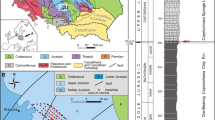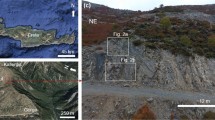Abstract
This study investigates the effects of some commonly encountered constraints such as inclined scanning trajectory, multiple targets in the vicinity and material variation on GPR responses of pipes and walls. Further, the effects of wall inclination and broken walls are also explored in GPR signatures. Interpretation of such signatures in GPR data for archaeological and geotechnical surveys has been a challenge. A physical model was created to simulate buried pipes and walls under controlled conditions by maintaining density and moisture content of the soil medium. The presence of PVC pipes, plastered brick and stone walls buried in the dry sand have been investigated and major observations have been reported. The inclined scanning trajectory on buried pipes shows a change in curvature of hyperbola-like signatures. Inclined transects near the ends of pipes and walls manifest single limb GPR signatures. The responses of multiple pipes and walls show dependence on separation of targets and footprint of an antenna. One can discern stone walls from brick walls by recognizing the diffraction of waves by irregular stones in GPR responses. The signatures of walls differ from pipes with respect to the width of the apex and variation in the intensity in the limb.












Similar content being viewed by others
References
Ahmadi R, Fathianpour N, Norouzi GH (2015) Detecting physical and geometrical parameters of some common geotechnical targets through their effects on GPR responses. Arab J Geosci 8(7):4843–4854
Annan AP, Cosway SW (1992) Simplified GPR beam model for survey design. In: 1992 SEG annual meeting. Society of Exploration Geophysicists
Blinn JF (1977) Models of light reflection for computer synthesized pictures. ACM SIGGRAPH Comput Graph 11(2):192–198
Burger HR (1992) Exploration geophysics of the shallow subsurface. Print Hall, Englewood Cliffs
Conyers LB (2009) Ground-penetrating radar for landscape archaeology: method and applications. In: Seeing the Unseen. Geophysics and Landscape Archaeology. CRC Press, pp 245–255
Conyers LB (2011) Discovery, mapping, and interpretation of buried cultural resources non-invasively with ground-penetrating radar. J Geophys Eng 8(3):S13
Conyers LB (2012) Interpreting ground-penetrating radar for archaeology. Left Coast Press, Routledge
Conyers LB, Goodman D (1997) Ground-penetrating radar. An introduction for archaeologist. AltaMira Press, Beverly Hills
Daniels JJ (2000) Ground penetrating radar fundamentals. Prepared as an appendix to a report to the US EPA, region V, pp 1–21
Ge R (2009) New progress of GPR to detect underground pipelines. In: ICPTT 2009@ advances and experiences with pipelines and trenchless technology for water, sewer, gas, and oil applications, ASCE, pp 803–809
Karim HH, Al-dami HA (2012) GPR data simulation for detecting subsurface bodies. Eng Tech J 30(15):2677–2693
Karim HH, Joni HH, Dawood AA (2016) Ground penetrating radar technique for assessing pavement thicknesses and bridge deterioration. Int J Curr Eng and Technol 6(5):1770–1779
Leckebusch J, Peikert R (2001) Investigating the true resolution and three-dimensional capabilities of ground-penetrating radar data in archaeological surveys: measurements in a sand box. Archaeol Prospect 8(1):29–40
Li S, Cai H, Abraham DM, Mao P (2014) Estimating features of underground utilities: hybrid GPR/GPS approach. J Comput Civil Eng 30(1):04014108
Lyon RF (1993) Phong shading reformulation for hardware renderer simplification. Apple Technical Report 43, Apple Computer, Inc., Cupertino
Maas C, Schmalzl J (2013) Using pattern recognition to automatically localize reflection hyperbolas in data from ground penetrating radar. Comput Geosci 58:116–125
Negri S, Quarta TAM (2012) Ground penetrating radar survey for civil-engineering applications: results from the test site. In: GPR, 2012 14th international conference, IEEE, pp 835–839
Pharr M, Humphreys G (2004) Physically based rendering: from theory to implementation. Morgan Kaufmann, Burlington
Ristic AV, Petrovacki D, Govedarica M (2009) A new method to simultaneously estimate the radius of a cylindrical object and the wave propagation velocity from GPR data. Comput Geosci 35(8):1620–1630
Shi X, Wu K (2014) Ground-penetrating radar (GPR) applied to detect underground pipes. In: International conference on pipelines and trenchless technology 2014 (ICPTT)
Shihab S, Al-Nuaimy W (2005) Radius estimation for cylindrical objects detected by ground penetrating radar. Subsurf Sens Technol Appl 6(2):151–166
Windsor CG, Capineri L, Falorni P (2005) The estimation of buried pipe diameters by generalized hough transform of radar Data. PIERS Online 1(3):345–349
Zhang P, Muhammat N (2014 May). A new method on probing and interpreting underground pipeline’s diameter by GPR. In: Tunneling and underground construction, ASCE, pp 855–886
Acknowledgements
The authors would like to acknowledge the support provided by Mr. Lal Singh from Relcon Infra Projects Limited in constructing the experimental setup. The authors would like to thank Archaeological Sciences Center of Indian Institute of Technology Gandhinagar, Archaeological survey of India (ASI) and Ministry of cultures for their support and encouragement.
Author information
Authors and Affiliations
Corresponding author
Ethics declarations
Conflict of interest
The sole interest of the work is to share knowledge and the authors have no conflict of interest in presenting this work.
Ethical Standards
This is an original work and complies with ethical standards expected in presenting this manuscript. All the references have been duly sited and the contributors acknowledge to the best of the authors’ knowledge.
Human and Animal Rights
This work did not involve any human participants and animals.
Informed Consent
All the authors have participated in developing this manuscript and given their consent for submission of this manuscript for possible publication in Journal of Geotechnical and Geological Engineering.
Rights and permissions
About this article
Cite this article
Thakur, M.M., Prashant, A. GPR Signatures of Pipes and Walls with Emphasis on the Effect of Inclined Scanning Trajectory. Geotech Geol Eng 35, 1977–1989 (2017). https://doi.org/10.1007/s10706-017-0221-0
Received:
Accepted:
Published:
Issue Date:
DOI: https://doi.org/10.1007/s10706-017-0221-0




